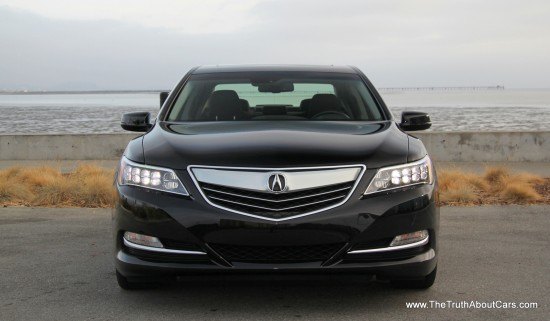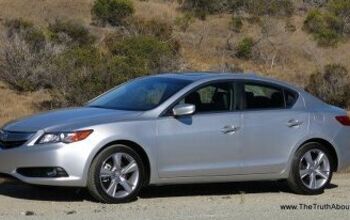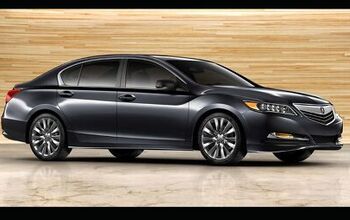Review: 2014 Acura RLX (With Video)

Breaking into the Luxury market isn’t easy. Toyota has arguably had the most success with Lexus, the only full-line luxury marque sold in America that isn’t German. Infiniti gave up on trying to go head-to-head with the S-Class and 7-Series when they ditched the Q, and Cadillac has yet to have a complete and coherent strategy. Meanwhile Acura started off strong with the Legend, created a competent E/5 competitor with the all-wheel-drive RL, and then things started to fall apart. Can the RLX bring the brand back?
Why do I bring up Germans in a review of a front-wheel-drive luxury sedan? Because some folks [not everyone mind you] at Acura and plenty of fan boys would like to think the brand runs with the big dogs. In truth Acura has always been a “near-luxury” brand because they lack a full-size competitor to play in the S-Class/7-Series/A8 pool.
Competition
In order to look at the RLX through the right lens, we need to nail down the competition. Acura would like you to believe the front-wheel-drive RLX should be pitted against the rear-wheel-drive BMW 528/535, Mercedes E350 and Lexus GS350. I think this comparison has a few problems. First, the RLX isn’t as dynamic as a RWD sedan. Second, Acura’s brand position is a problem. What say our readers? Should the brand matter in comparisons? Should this all be priced based? In my mind the RLX’s drivetrain and the brand’s near-luxury image put the Acura in direct competition with the Cadillac XTS, Lincoln MKS and Volvo S80. What about the FWD/AWD A6? Perhaps, but Audi’s brand is a solid BMW/Mercedes competitor these days.
Exterior
Acura’s flagship has always worn elegant and restrained sheetmetal and that continues with the RLX. Up front we get a more muted and better integrated version of Acura’s signature “beak” flanked by multi-beam LED headlamps. The LED high and low beams are standard on every RLX and strike a unique pose as identifiable as BMW’s “angel eyes.”
The RLX’s rump is probably the best looking in Acura’s current product portfolio. I’ve never cared for the jumble of shapes on the TL’s back side, thankfully none of them are along for the ride. In an interesting twist, Acura put the RLX’s quad exhaust tips behind the bumper where you can’t see them instead of integrating them into the bumper cover as in the smaller TL. Looking at the RLX from the side it’s obvious this car has grown. The rear doors give the Acura a more luxurious look than the old RL which had a decidedly Accord-like silhouette. A long front overhang advertises the transverse engine layout in the RLX, but that’s not really a problem with our pre-defined competition since the two Americans and the Swede are all FWD platforms as well.
In my opinion, the RLX’s exterior ranks second behind the 2014 Volvo S80’s clean lines. Yes the Volvo is getting old, but frequent refreshed have helped it age well. I like Caddy’s art-and-science design theme on every Caddy except the XTS where I find the proportions to be awkward. However Awkward trumps the ginormous and bizarre schnoz on the Lincoln MKS.
Interior
The RLX’s interior is one place where I can not only compare the Acura to the Germans, it’s an area where Acura excels. You won’t find a full-on stitched leather dash like the Volvo S80 or the Mercedes E350 with the “designo” package, but you can “option up” a band of stitched leather running across the cabin. Anyway you order your RLX, perfect seams and a tasteful amount of metallic trim are standard. You’ll also find perfect seams and fit and finish quality that would make Lexus blush. What you won’t find is real tree. The choice of fake wood on upper trim levels perplexes me when all the RLX competitors slather the cabin in acres of burl. (Base RLX models get faux-metal trim.) When it comes to interior styling and quality, I rank the RLX above the E350, 528i, S80, MKS, XTS, GS350, and yes, even the A6.
Front seat comfort ranks second in this quartet behind Volvo’s large and supportive thrones. Enlarging the pool only drops the Acura to third place above the BMW 5-series’ standard seats but behind the optional million-way sport buckets. Oddly however, those seats aren’t covered in leather in base RLX models. Want real moo? That’ll be $6,000 more than the RLX’s base $48,450. This may be in line with Lexus’ recent move in the GS, but the RLX’s closest competition comes with real leather standard.
Rear passengers have notably more room than the outgoing RL with legroom and headroom in line with everyone else. While Lincoln and Cadillac cut corners in the back, Acura delivers rich plastics and an attention to detail that places it first in thus class and certainly on par with BMW’s 5.
Infotainment
Since my first experience with AcuraLink, the system has grown on me, and in the RLX the dual screens are very well integrated into the dashboard rather than looking like an afterthought as in the Honda. AcuraLink is without question snappier than MyLincoln Touch or Cadillac’s buggy CUE system. I find Volvo’s Sensus interface more intuitive, but you need binoculars to use the microscopic LCD.
Two screens might be standard on the $48,450 base model, but navigation is not. Want maps? That bumps the price to $50,950. For $54,450 Acura will bump the speaker count from 10 to 14, watts from 404 to 588, add sound deadening side glass, rain sense wipers, and folding side mirrors. If you want the Krell audio and all the electronic goodies like radar cruise, lane keep assist, parking sensors, dimming side mirrors, ventilated front seats and heated rear seats that bumps the price of the RLX to an eye watering $60,450. Ouch.
Drivetrain
Acura’s only engine for 2014 is a direct-injected 310HP 3.5L V6 that cranks out 272lb-ft of torque. In typical Acura fashion peak power comes at 6,500 RPM, torque comes to a boil at a lofty 4,500 RPM and the six-pot is smooth as butter at every RPM. 310 ponies used to be something to brag about, unfortunately this is 2014 and the RLX’s mill only leads when you compare it to base engines in the competition. The problem is everyone but Acura offers a more powerful engine option. If you think nobody options up, let’s look at the numbers. Lincoln says over 30% of MKS shoppers opt for their twin-turbo V6 which puts down 19% more power and 30% more torque. My local Volvo dealer says the take rate on the twin-scroll turbo S80 with AWD (300 horsepower and 325lb-ft, 20% more twist) is nearly 80% and I’m not in the snow belt. It remains to be seen how many of the fire-breathing twin-turbo 410 horse V6s Cadillac ships in the XTS, but judging by the competition I expect them to shift a few. The Germans? Their twin-turbo V8s are in a different performance ballpark but the 443 horsepower 550i starts just $3,500 more than the top-end RLX.
Power isn’t the only area where the RLX is at a competitive disadvantage, Acura also dropped their Super Handling AWD system from their flagship. Acura’s torque vectoring AWD, capable of continually varying the FWD/RWD bias, set the old RL apart (and ahead) from the pack. Yes, there will be a hybrid AWD RLX soon we are told, but with a maximum of around 60 horsepower at the rear wheels the 370HP RLX hybrid is likely to retain a strong FWD bias. (The system will not have a mechanical connection between the engine and rear wheels. Instead there will be a ~40HP motor/generator between the engine and transaxle and an approximately 28HP motor at each rear wheel.) The less sophisticated AWD systems found in the MKS, XTS and S80 are suddenly the choice for driving enthusiasts.
Drive
The lack of AWD has a huge impact in the way the RLX drives compared to its predecessor. The old RL was a hoot and a half on winding mountain roads. In comparison, the RLX is three-quarters of a hoot. The old RL was capable of sending the majority of the engine’s power to the outside rear wheel making it corner with precision and confidence. When pushed to its limits, the front-heavy RL understeered predictably. The RLX on the other hand is probably one of the most capable front drivers on the market, easily more capable than the FWD Lincoln, Cadillac or Volvo but slots behind AWD versions of the same.
Acura’s “Precision All Wheel Steer” system (dubbed P-AWS) is the reason for the RLX’s crisp handling. P-AWS differs from other systems on the market in that it can rotate the rear wheels independently of one another allowing the car to toe both wheels in when braking. That might sound odd, but doing so keeps the RLX’s rear end from feeling “squirely” under hard braking, something usually associated with nose-heavy sedans. P-AWS is tuned to “mimic” oversteer as much as possible in corners leading to a peculiar combination of slight torque steer, [very] mild oversteer and a hint of wheel hop all at the same time. This is a confluence of personalities you will find only in the RLX. Helping out is an always-active stability control system. Unlike the stability control on most cars which only intervene when things go pear-shaped, this system is always playing with the brakes trying to “improve” the handling characteristics of the RLX. Paired with electric power steering these systems make the RLX the best handling, but the most artificial large FWD sedan I have ever driven.
Our RLX was equipped with Acura’s “Lane Keep Assist” system which uses the electric power steering system to help keep you in your lane. Unlike all the other systems on the market, on a freeway the LKA system is almost always providing some level of steering assistance. Acura likens the aid to a ball riding in a “U” shaped trough, the closer you get to the lane lines, the more the system assists. I don’t know if I have formed an opinion on the system yet, but it did work as advertised and can be turned off completely.
If you’ve been keeping score, I found the RLX to be the second most attractive on the outside, have the best interior, second most comfortable seats, best infotainment system, best handling numbers, a middling engine and questionable behind-the-wheel-feel. One might assume this puts the RLX towards the top of the quartet, and perhaps a viable alternative to the Germans. One would be wrong. The RLX is unquestionably a good car, but it’s $3,200 more than a similarly configured FWD XTS, $8,275 more than the FWD Volvo S80 and $9,990 more than the FWD MKS. Things get worse when you load up the Lincoln and Volvo with the more powerful S80 T6 AWD still $5,000 cheaper and the 365HP MKS Ecoboost AWD $3,000 less expensive. Only Cadillac’s 410HP XTS VSport is more expensive ranging from $62,000-$72,000. The news is just as grim when pitted against the luxury competition with the RLX being $1,300 more than the Lexus GS350, $1,200 less than the Infiniti M37, and only a $3,000 discount compared to the E350 and BMW 535i. The result is the RLX has no “value” proposition to counter the middling engine numbers, FWD bias, road feel and most importantly: the brand image. Sadly I fear the RLX is about $10,000 away from being a great car and $15,000 away from being a game changer. Until Acura realigns their flagship’s capabilities (or shrinks the price tag) the RLX is destined to be the car everyone likes but nobody buys.
Acura provided the vehicle, insurance and one tank of gas for this review.
Specifications as tested
0-30: 2.38 Seconds
0-60: 5.72 Seconds
1/4 Mile: 14.28 Seconds @ 99 MPH
Average Observed Fuel Economy: 23 MPG over 781 miles

More by Alex L. Dykes
Latest Car Reviews
Read moreLatest Product Reviews
Read moreRecent Comments
- ToolGuy If these guys opened a hotel outside Cincinnati I would go there to sleep, and to dream.
- ToolGuy Michelin's price increases mean that my relationship with them as a customer is not sustainable. 🙁
- Kwik_Shift_Pro4X I wonder if Fiat would pull off old world Italian charm full of well intentioned stereotypes.
- Chelsea I actually used to work for this guy
- SaulTigh Saw my first Cybertruck last weekend. Looked like a kit car...not an even panel to be seen.




































































Comments
Join the conversation
The RLX is not Honda's answer to the lux market in the US. This model, as well as the previous Legend models, were produced for the Japanese market. The market in Japan is completely different than ours. Hence the very strong sales of the RLX there. Honda doesn't find the need to produce a V8 for it's targeted consumer in Japan. Regardless, the attention to detail Honda engineers put into this model would be consider
considered "extreme" by the Americans or even the Germans. Honda obviously knows what the Americans want. Simply look at the stats. Americans love their Hondas...